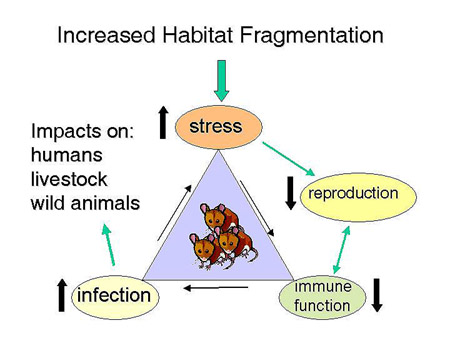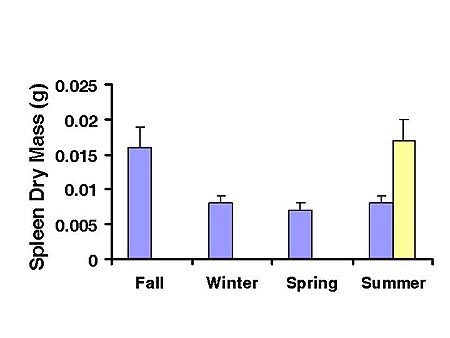Effects of habitat size on stress, immunocompetence,
and parasitic infections in free living populations of white-footed mice
(Peromyscus leucopus)
Funded By:
National Science Foundation EPSCoR
The Committee on Institutional Studies and
Research, MSU
Infectious diseases
that affect wild and domestic animal and human populations are increasing
in prevalence worldwide. Most of these diseases have been associated
with alteration of natural habitats by humans (e.g., agriculture, urbanization)
that, presumably, causes increased stress in wild animal populations.
As wild animal populations become more stressed, they are also more likely
to carry parasites and diseases. As a result, humans living in
areas near to disturbed habitats may have an increased risk of exposure
to disease. Dr. Claire Fuller and I are investigating the relationships
among habitat disturbance, stress, immunocompetence, and disease in wild
populations of Peromyscus leucopus (white-footed mouse). We
will determine and compare the levels of stress (as indicated by glucocorticoids)
and dietary protein, levels of innate, humoral, and cell-mediated immune
function, and prevalence of parasitic infections in wild white-footed
mouse in small and large patches of habitat in winter and summer.
Our long-term objective is to produce and assess GIS-based models that
predict the threat that habitat alteration poses to the health of wild
mammal populations and the risk of disease incurred by nearby human populations.

Because species such
as the white-footed mice live in
close proximity of populated areas, humans and their domesticated
animals, as well as other wild animals will be at greater risk
of contracting disease from stressed animals.
|
We predict that as habitats become increasingly fragmented, there
will be a reduction in reproduction and immunocompetence.
As immunocompetence
is reduced, animals will become more susceptible to infections
and disease.
|

|
Our test species, the white-footed mouse (Peromsycus
leucopus) carries diseases such as Hanta Virus and Lyme disease,
both of which are very hazardous to humans.

|
Through the research of
a graduate student (Cynthia Hornung), we have already documented that
there are seasonal changes in the mass of the spleen, an organ important
to immune function, and in diet composition. The spleen of adult
males (below- blue histogram bars) is enlarged in white-footed mice captured
in the fall compared with other seasons. The spleen is also greatly
enlarged in lactating females (below - yellow histogram bar).
The amount of protein in the diet peaks during summer in males, probably
due to the abundance of insects available. Ingestion of fiber, as
a percent of the total diet, is greatest in males in spring as tender
plant shoots that are easily digested become available. Differences
in parameters such as these may occur when comparing mice from small and
large habitat fragments.
|

Figure 1. Seasonal measurements of the dry
mass of the spleen in adult male white-footed mice. Values
are also given for lactating females (yellow bar) captured in summer.
|

Figure 2. Seasonal estimates of the amount of dietary fiber
and protein in adult male white-footed mice. Values are also
given for lactating females captured during |




